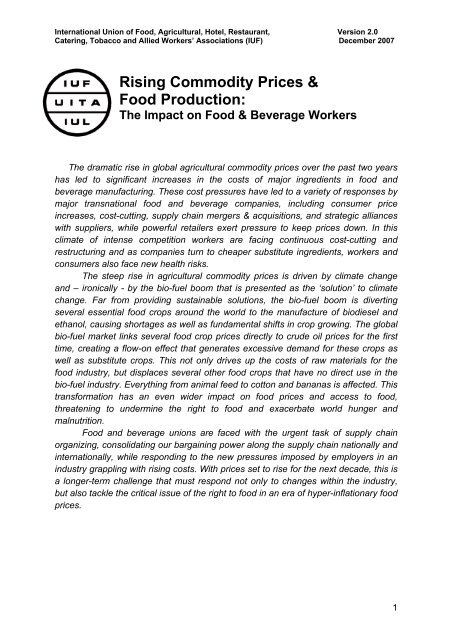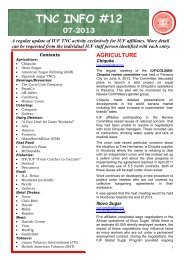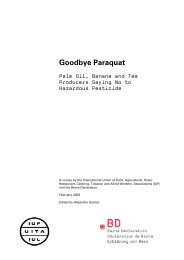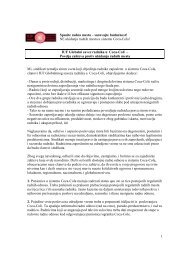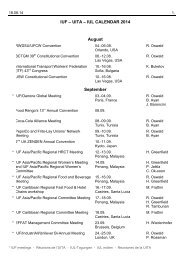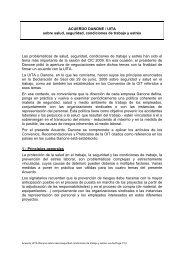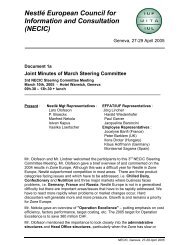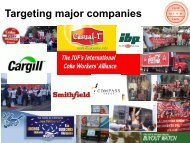Rising Commodity Prices & Food Production:
Rising Commodity Prices & Food Production:
Rising Commodity Prices & Food Production:
Create successful ePaper yourself
Turn your PDF publications into a flip-book with our unique Google optimized e-Paper software.
International Union of <strong>Food</strong>, Agricultural, Hotel, Restaurant, Version 2.0<br />
Catering, Tobacco and Allied Workers’ Associations (IUF) December 2007<br />
<strong>Rising</strong> <strong>Commodity</strong> <strong>Prices</strong> &<br />
<strong>Food</strong> <strong>Production</strong>:<br />
The Impact on <strong>Food</strong> & Beverage Workers<br />
The dramatic rise in global agricultural commodity prices over the past two years<br />
has led to significant increases in the costs of major ingredients in food and<br />
beverage manufacturing. These cost pressures have led to a variety of responses by<br />
major transnational food and beverage companies, including consumer price<br />
increases, cost-cutting, supply chain mergers & acquisitions, and strategic alliances<br />
with suppliers, while powerful retailers exert pressure to keep prices down. In this<br />
climate of intense competition workers are facing continuous cost-cutting and<br />
restructuring and as companies turn to cheaper substitute ingredients, workers and<br />
consumers also face new health risks.<br />
The steep rise in agricultural commodity prices is driven by climate change<br />
and – ironically - by the bio-fuel boom that is presented as the ‘solution’ to climate<br />
change. Far from providing sustainable solutions, the bio-fuel boom is diverting<br />
several essential food crops around the world to the manufacture of biodiesel and<br />
ethanol, causing shortages as well as fundamental shifts in crop growing. The global<br />
bio-fuel market links several food crop prices directly to crude oil prices for the first<br />
time, creating a flow-on effect that generates excessive demand for these crops as<br />
well as substitute crops. This not only drives up the costs of raw materials for the<br />
food industry, but displaces several other food crops that have no direct use in the<br />
bio-fuel industry. Everything from animal feed to cotton and bananas is affected. This<br />
transformation has an even wider impact on food prices and access to food,<br />
threatening to undermine the right to food and exacerbate world hunger and<br />
malnutrition.<br />
<strong>Food</strong> and beverage unions are faced with the urgent task of supply chain<br />
organizing, consolidating our bargaining power along the supply chain nationally and<br />
internationally, while responding to the new pressures imposed by employers in an<br />
industry grappling with rising costs. With prices set to rise for the next decade, this is<br />
a longer-term challenge that must respond not only to changes within the industry,<br />
but also tackle the critical issue of the right to food in an era of hyper-inflationary food<br />
prices.<br />
1
International Union of <strong>Food</strong>, Agricultural, Hotel, Restaurant, Version 2.0<br />
Catering, Tobacco and Allied Workers’ Associations (IUF) December 2007<br />
1. <strong>Rising</strong> Agricultural <strong>Commodity</strong> <strong>Prices</strong><br />
Over the past two years the prices of several major agricultural commodities have<br />
increased dramatically, driving up production costs in the food and beverage industry<br />
globally and fuelling inflation.<br />
In the last 12 months alone the world market prices of maize [corn] and barley<br />
increased 30% and 50% respectively, while the price of wheat rose 65%. 1 Maize<br />
prices were already on the rise for the past three years and it is expected that prices<br />
will continue to rise for the next decade, as global cereal stocks fall to their lowest<br />
level in 24 years.<br />
These global price shifts were reflected in far sharper price increases in national<br />
markets, with the price of wheat doubling and the price of maize quadrupling in some<br />
countries. The rising cost of cereals and grains has driven up production costs in<br />
food processing as well as breweries. Financial analysts predict that grain prices will<br />
rise by another 40% by 2020, concluding that: “<strong>Food</strong> and beverages processors will<br />
be fighting it out for an increasingly dwindling supply of grains sourced at even<br />
higher prices.” 2<br />
At the same time edible oils – crucial ingredients in the food industry – have reached<br />
record highs. <strong>Prices</strong> of rapeseed [canola] oil, soybean oil and palm oil are setting<br />
new records. Soybean prices rose by 56% to hit the highest level in 20 years and will<br />
continue to rise as Chinese imports surge, consuming 45% of the total global trade in<br />
soybean. At the same time both China and India– the two largest consumers of<br />
edible oils in the world – have increased imports of palm oil. 3 Crude palm oil prices<br />
exceeded RM 3,000 (US$909) per tonne in January, before falling to an average RM<br />
2,500 per tonne. This is still 65% higher than the previous year. With shortages of<br />
soybean oil, palm oil and rapeseed oil, the price of sunflower oil has increased by<br />
56% - its highest level in 19 years.<br />
<strong>Food</strong> and beverage manufacturers have also been hit by higher prices of cocoa,<br />
coffee and milk. Global milk prices have risen 50% this year and are expected to rise<br />
another 30% next year. According to the FAO skim milk powder (SMP) and whole<br />
milk powder (WMP) prices are 125% higher than last year, while cheese prices are<br />
88% higher and butter 125% higher. 4<br />
1 FAO <strong>Food</strong> Outlook, November 2007.<br />
2 “Grain prices could rise by another 40 per cent says ING”, <strong>Food</strong> <strong>Production</strong> Daily, 27 November<br />
2007.<br />
3 FAO <strong>Food</strong> Outlook, November 2007; William Bi, “Chinese demand to boost soybean, palm oil<br />
prices”, Bloomberg, 20 November 2007. China is the single largest consumer of palm oil, purchasing<br />
mainly from Malaysia. In 2006 China imported 3.57 million tones of palm oil and palm oil products<br />
valued at US$2.5 billion. This was equivalent to 25% of Malaysia’s total production of palm oil.<br />
Imports of palm oil into India reached 2.62 million tones, an increase of 32% over the previous year.<br />
4 FAO <strong>Food</strong> Outlook, November 2007. For an explanation of this rise in global milk prices, please see<br />
the briefing “Global Milk <strong>Prices</strong>” prepared by the New Zealand Dairy Workers Union (DWU).<br />
2
International Union of <strong>Food</strong>, Agricultural, Hotel, Restaurant, Version 2.0<br />
Catering, Tobacco and Allied Workers’ Associations (IUF) December 2007<br />
In 2006 Asia became the world’s largest milk production region, accounting for 34% of global<br />
output. New Zealand and Australia are the two largest global milk exporters and India is the<br />
world’s largest single milk producing country. 5 China is the third largest milk producer in the<br />
world following the US and India. While dairy consumption rose 20% in China over the past<br />
five years, the Dairy Association of China estimates that consumption will rise 15 to 20%<br />
annually in the coming years. 6 Pakistan – where Nestlé has just opened the company’s<br />
largest milk processing facility in the world with a capacity of two million litres a day - is the<br />
world's fifth-largest milk producer.<br />
<strong>Rising</strong> milk prices is fuelling inflation in several countries in the region. In Sri Lanka a<br />
20% jump in consumer prices in 2007 was largely driven by rising milk prices,<br />
specifically the higher price of imported SMP. In other countries it was the combined<br />
effect of higher vegetable oil prices and milk prices. <strong>Food</strong> prices rose by 18.2% in<br />
China, 8.4% in India, and 13% in Indonesia and Pakistan in 2007. It is significant that<br />
while in the EU food prices account for 15.6% of consumer price inflation, in Asia<br />
food prices account for 55%.Thus rising food prices – and energy prices – mean that<br />
living costs have increased sharply. Even where countries are major exporters of<br />
edible oils, domestic prices are rising. In Indonesia, the world’s largest producer of<br />
palm oil, where palm oil has become the main cooking oil and a food ingredient in<br />
staple foods such as instant noodles, domestic palm oil prices rose by 50% in the<br />
first 10 months of 2007. 7<br />
So how long will it last While some food companies have treated these price<br />
increases as a short-term phenomenon, the OECD-FAO Agricultural Outlook 2007-<br />
2016 report suggests we are facing a much longer-term rise in prices. The reason is<br />
that rising prices are due less to temporary or seasonal or cyclical factors than<br />
deeper structural changes in agricultural production and consumption. Changing<br />
consumption in developing countries – particularly China – will keep prices of milk<br />
and other agricultural products high for the next decade. But a more fundamental<br />
change is driven by the bio-fuel industry. 8<br />
2. The Bio-fuel Boom<br />
There are two major bio-fuels in use today: biodiesel and ethanol. All the major<br />
edible oil crops are now used to produce biodiesel: rapeseed [canola]; palm nut;<br />
coconut; sunflower seed; groundnut; and cotton seed; as well as staple food crops<br />
such as soybean.<br />
Ethanol is made primarily from food crops such as sugar cane, maize, wheat, sugar<br />
beet and cassava. The largest market for maize-based ethanol is the US, which<br />
used almost 54 million tonnes of maize for this purpose in 2006/07, with maize<br />
5 “Asia is the world’s largest milk production region”, FAO, 3 January 2007. India overtook the US as<br />
the world’s largest milk producer in 1998.<br />
6 “Farmers jubilate as milk prices rise to record highs”, Associated Press, 12 August 2007.<br />
7 “Worldwide surge in vegetable oil prices”, www.allaboutfeed.net, 21 November 2007.<br />
8 OECD-FAO Agricultural Outlook 2007-2016. OECD/FAO, Paris 2007.<br />
3
International Union of <strong>Food</strong>, Agricultural, Hotel, Restaurant, Version 2.0<br />
Catering, Tobacco and Allied Workers’ Associations (IUF) December 2007<br />
planting covering the largest area since 1944. The US is forecast to increase its use<br />
of maize to 81.3 million tonnes in 2007/08. 9 In China too maize-ethanol is the main<br />
bio-fuel, with industrial use of maize expected to reach 40 million tonnes by 2020. 10<br />
The increased demand for food crops to manufacture biodiesel and ethanol has<br />
driven up crop prices, with a spill-over effect on the cost of other edible oil crops as<br />
substitutes in food production. The diversion of rapeseed to biodiesel production in<br />
Europe has led to increased demand for imported edible oils, further driving up<br />
global prices. In the US the diversion of soybean to biodiesel production has also<br />
raised global prices.<br />
As the bio-fuel industry develops a voracious appetite for edible oil crops and maize,<br />
the cost of raw materials and food ingredients derived from these crops is rising<br />
dramatically. Palm oil, now used widely in food products ranging from instant<br />
noodles to biscuits and ice cream, has become so integrated into energy markets<br />
that its price moves in tandem with crude oil prices. 11<br />
The impact of bio-fuel demand for food crops has both direct and indirect effects.<br />
The massive shift in use of maize and wheat for ethanol production has led to<br />
increased costs of animal feed which in turn translates into higher costs in the meat<br />
and dairy industries. At the same time the desire to cash in on the bio-fuel boom has<br />
led to the conversion of land to grow maize for ethanol instead of other food crops. 12<br />
As the OECD-FAO Agricultural Outlook 2007-2016 observes:<br />
Growing cereal use for ethanol leads to a reduction in planted acreage to oilseeds,<br />
particularly in the US, in favour of maize. Increasing cereal prices relative to those for<br />
oilseeds caused this land reallocation. As a knock-on effect, oilseed prices then also<br />
increased as a result of tightening supplies and this price strength was enhanced by<br />
rising demand for meals as a cereal feed substitute and increasing demand for<br />
vegetable oils for bio-diesel production. 13<br />
The effects are felt well beyond the US where heavily subsidized maize has been<br />
dumped on world markets for decades. Until the bio-fuel boom diverted maize to<br />
ethanol production, US maize exports accounted for more than half the global trade<br />
in maize. Under the North American Free Trade Agreement (NAFTA), Mexico – a<br />
country in which maize is a traditional food crop - has become dependent on imports<br />
of heavily subsidized animal-feed grade maize from the US. 14 The shift to ethanol<br />
9 FAO <strong>Food</strong> Outlook, November 2007.<br />
10 Xie Chuanjiao, “Ethanol output has corn prices popping”, China Daily, 6 December 2006.<br />
11 Patrick Barta, “Biofuel costs damp bid to curb crude prices”, The Wall Street Journal, 5 November<br />
2007. The China Daily quotes a futures trader on the Dalian <strong>Commodity</strong> Exchange saying that: "We<br />
predict that agricultural products will be as hot as petroleum in the future.” Xie Chuanjiao , “Ethanol<br />
output has corn prices popping”, China Daily, 6 December 2006.<br />
12 P. Thoenes, “Biofuels and commodity markets – palm oil focus”, Commodities and Trade Division,<br />
FAO, October 2006.<br />
13 OECD-FAO Agricultural Outlook 2007-2016, OECD/FAO, Paris: 2007.<br />
14 US maize was dumped on world agricultural markets at 25 to 30% below the cost of production and<br />
in 2002 5.55 million tonnes was dumped in Mexico using NAFTA rules. Institute for Agriculture and<br />
4
International Union of <strong>Food</strong>, Agricultural, Hotel, Restaurant, Version 2.0<br />
Catering, Tobacco and Allied Workers’ Associations (IUF) December 2007<br />
production in the US had an immediate impact on maize prices in Mexico, fuelling<br />
inflation and exacerbating hunger and starvation among the urban poor, leading to<br />
food riots.<br />
The massive increase in palm oil production to feed the bio-fuel industry has had a<br />
devastating effect in Asia and the Americas. The Emergency Resolution on biofuels<br />
adopted by the 25 th IUF Congress held in March 2007, points out that biofuels<br />
“are produced in poor social conditions, demand extensive use of pesticides<br />
and water, [and] cause deforestation.” The Resolution on defence of the food<br />
sovereignty of peoples also condemns the destructive impact of palm oil<br />
plantations on the environment, family faming and agricultural employment, and<br />
observes that “… the production of bio fuels based on sugar cane, the African palm<br />
and soya is giving rise to an intensive process of agrarian counter reform.”<br />
The UN Special Rapporteur on the right to food, Jean Ziegler, issued a stern warning<br />
against the bio-fuel boom in his report to the UN General Assembly on 25 October<br />
2007:<br />
Rushing to turn food crops – maize, wheat, sugar, palm oil – into fuel for cars, without<br />
first examining the impact on global hunger is a recipe for disaster. It is estimated<br />
that to fill one car tank with biofuel (about 50 litres) would require about 200 kg of<br />
maize – enough to feed one person for one year.<br />
Arguing that “it is a crime against humanity to convert food crops to fuel”, Ziegler<br />
called for a five year moratorium on bio-fuels to assess their social, economical and<br />
environmental impact. 15<br />
3. Transnational Corporate Strategies<br />
How have transnational food and beverage companies responded to higher<br />
commodity prices and the bio-fuel boom There are for main corporate strategies:<br />
i) passing on higher costs to consumers<br />
ii) mergers, acquisitions & strategic alliances to secure supplies<br />
iii) absorbing higher costs & cost-cutting<br />
iv) using cheaper substitute ingredients<br />
i) Let the consumers pay<br />
The short-term response of most companies has been to raise end-product prices<br />
with the expectation that consumer loyalty to strong brand names will ensure that<br />
sales won’t suffer. This was Nestlé’s strategy when raising prices of Kit-Kat and<br />
Trade Policy (IATP), United States Dumping on World Agricultural Markets. Cancun Paper Series<br />
No.1, 203, pp.3; 9<br />
15 Report of the Special Rapporter on the right to food, 62 nd Session of the United Nations General<br />
Assembly, 22 August 2007.<br />
5
International Union of <strong>Food</strong>, Agricultural, Hotel, Restaurant, Version 2.0<br />
Catering, Tobacco and Allied Workers’ Associations (IUF) December 2007<br />
Nescafe branded products. Similarly Danone raised the price of its strongest yoghurt<br />
brands twice in 2007. 16<br />
However, there are limits to raising supermarket shelf prices, even if brand loyalty is<br />
certain. One reason is that retail concentration over the past decade has significantly<br />
increased the power of major supermarket chains vis-à-vis food and beverage<br />
companies. So raising prices is only viable if companies can still secure shelf space<br />
for their branded products. This applies not only to developed countries, but also<br />
developing countries such as Thailand (Tesco-Lotus) and Indonesia (Carrefour).<br />
The impact of this retail concentration is far-reaching. As the Composite Resolution<br />
on concentration, competition and own brands in the retail sector adopted by<br />
the 25 th IUF Congress noted:<br />
… cut-throat price competition in the retail sector and below-cost selling, together with<br />
the increased use of practices such as strict return policies and the levying of sales<br />
promotion and distribution centre fees, stymies fair retail transactions, forces the food<br />
and other industries to reduce prices and, through the pressure exerted on suppliers,<br />
jeopardizes food safety and quality as well as the health, job security, training and terms<br />
and conditions of workers generally as well as those employed by suppliers.<br />
The power of retailers means that food and beverage companies must find and<br />
secure cheaper of raw materials and/or manage these costs internally.<br />
ii) Securing Supplies<br />
Major transnational food and beverage companies are implementing global supply<br />
chain management strategies that involve strategic alliances with suppliers,<br />
exclusive long-term supply contracts, as well as takeovers and acquisitions along the<br />
supply chain.<br />
For example, Indonesia’s largest food company and the world’s largest manufacturer<br />
of instant noodles, Indofood, bought the 100-year old plantation company London<br />
Sumatra (Lonsum) for US$922 million. This secured acess to palm oil supplies, as<br />
well as cocoa, tea and coffee. 17<br />
Through its €1.7 billion acquisition of National <strong>Food</strong>s, Kirin, Japan’s second largest<br />
brewery, will secure access to Australian dairy products including processed milk,<br />
cheese and butter. 18 This will in turn strengthen the strategic partnership that Kirin<br />
formed with Yakult in June 2005.<br />
In addition to supply chain acquisitions, food companies are signing long-term supply<br />
agreements and forming strategic partnerships. The Japanese confectionary<br />
16 “Two yoghurt makers hike prices, others to follow”, Reuters, 11 October 2007.<br />
17 “Indofood gets shareholder nod for Lonsum deal”, just-food.com, 23 October 2007.<br />
18 “Kirin targets dairy for global expansion”, Dairy Reporter, 8 November 2007.<br />
6
International Union of <strong>Food</strong>, Agricultural, Hotel, Restaurant, Version 2.0<br />
Catering, Tobacco and Allied Workers’ Associations (IUF) December 2007<br />
manufacturer Morinaga signed a long-term supply agreement with Barry Callebaut,<br />
the world's largest chocolate maker 19 , for 9,000 metric tonnes of chocolate a year for<br />
the next 10 years. 20<br />
Earlier this year Nestlé formed a strategic partnership with Barry Callebaut to secure<br />
a long-term supply of chocolate mass for Nestlé’s Russian operations. As part of this<br />
deal Nestlé transferred its chocolate factory in Dijon, France, to Barry Callebaut,<br />
effectively outsourcing production. Barry Callebaut also took control of Nestlé's<br />
Italian cocoa liquor and liquid chocolate facility in Italy. 21 Such deals illustrate how<br />
corporate strategies to secure supplies of raw materials have a direct impact on<br />
workplace restructuring, including ownership change and outsourcing.<br />
Supply chain strategies such as these aren’t new. In 1998 Coca-Cola India created<br />
an International Trade Group (ITG) based in Bangalore to purchase commodities<br />
from India. The direct purchase 18,000 tonnes of green coffee annually now<br />
accounts for 90% of all transactions, making Coca-Cola Far East (the entity that<br />
operates the trading company) one the largest buyers of Indian coffee.<br />
Similar strategies are evident in milk. For the past 18 years Nestlé has developed an<br />
extensive network of direct purchasing from farmers, and now has contracts with<br />
140,000 farmers in Punjab alone. In March 2007 Nestlé opened its largest milk<br />
processing facility in the world with a capacity of two million litres a day. This is<br />
expected to be increased to three million litres per day in the future.<br />
But in India Nestlé now faces an intense battle with other transnational and local<br />
food companies trying to secure milk supplies. 22 The three companies that dominate<br />
the chocolate market – Cadbury, Nestlé and Amul – are faced with a 20% rise in<br />
production costs that must either be absorbed or passed on to consumers. Cadbury,<br />
which has a 72% market share, is in a better position to absorb higher milk prices,<br />
while the other companies are likely to raise consumer prices. 23 Meanwhile Danone<br />
is trying to secure a majority stake in a massive new dairy project in Rajasthan,<br />
India, which will have a capacity of three million litres per day. 24<br />
The reason for this intense competition is that local milk suppliers can get much<br />
higher prices for their produce on global markets. In India SMP sells locally for<br />
Rs.105/kg compared to a global price of Rs.200/kg. In response to this price<br />
difference two dozen dairies in Punjab, Haryana, UP and Rajasthan have shifted to<br />
19 “Meet the world’s biggest chocolate maker”, The Financial Times, 18 July 2007.<br />
20 “Barry Callebaut and Morinaga to form strategic alliance”, <strong>Food</strong> Business Review, 26 September<br />
2007.<br />
21 “Nestlé teams up with Barry Callebaut”, <strong>Food</strong> <strong>Production</strong> Daily, 16 February 2007; “Outsourcing<br />
boosts Barry Callebaut sales”, BakeryandSnacks.com, 28 June 2007.<br />
22 “Nestlé asking farmers to shift to cow milk”, The Hind Business Line, 12 April 2007; “Nestlé renders<br />
new look to dairying in Punjab”, The Hind Business Line, 7 November 2007.<br />
23 Ruhita Saxena, “Chocolate makers hit by rising raw material costs”, Business Standard (India), 23<br />
November 2007; “India among Cadbury’s top 12 global markets”, Economic Times, 21 November<br />
2007.<br />
24 “Danone seeks majority stake in Kenventer dairy project”, Economic Times, 29 November 2007.<br />
7
International Union of <strong>Food</strong>, Agricultural, Hotel, Restaurant, Version 2.0<br />
Catering, Tobacco and Allied Workers’ Associations (IUF) December 2007<br />
exporting SMP. 25 This caused a shortage of liquid milk and higher milk prices locally.<br />
In response the government banned SMP exports in February 2007, but lifted the<br />
ban only seven months later. As global prices for SMP continue to skyrocket, so too<br />
do Indian exports.<br />
The battle over milk supplies in India illustrates the way in which major food<br />
companies are up against powerful suppliers. This is no different at the global level.<br />
As the New Zealand Dairy Workers Union (DWU) briefing on global milk prices<br />
shows, Fonterra has become a “price fixer”:<br />
Fonterra is succeeding in its strategy of moving from being a price taker to being a<br />
price fixer. It now influences over 50% of global trade in dairy through its own<br />
exports, its joint ventures (e.g. DPA with Nestlé and the partnership with Dairy<br />
Farmers of America) and its marketing arrangements with companies like Sancor<br />
(Argentina).<br />
Suppliers of other agricultural commodities have also become price-fixers in global<br />
markets and in doing so have tremendous bargaining power vis-à-vis food and<br />
beverage manufacturers. Today more than half of all cocoa grindings worldwide are<br />
conducted by just five corporations: Archer-Daniels-Midland (ADM), Barry Callebaut,<br />
Cargill, Hamester and Blommer. 26 Cargill and ADM control 65% of the global cereals<br />
market and together with Bunge dominate oilseed crushing. 27 Bunge is the world’s<br />
largest oilseed processor. 28<br />
In response some food and beverage manufacturers are trying to reduce their<br />
dependence on agricultural commodities by diversifying their product lines. Nestlé,<br />
for example, is diversifying into nutritional foods through US$8 billion in acquisitions<br />
and is “seeking brands less threatened by surging commodity costs.” 29 Now<br />
chocolate and candy make up only 10% of Nestlé’s revenue, less than pet food.<br />
Similarly, as Kirin expands its acquisitions in the global dairy industry, it is also<br />
developing its range of non-milk dairy products in alliance with Yakult.<br />
However such moves will have a limited effect, since most companies must still<br />
focus on their core brands, and these brands generally depend on agricultural inputs,<br />
particularly products derived from oil crops and oilseeds.<br />
As a result food and beverage companies remain caught between the powerful<br />
retailers who are resisting product price increases and suppliers who are able to<br />
determine prices and effectively restrict access to raw materials.<br />
25 Nidhi Nath Srinivas, “Consumers of India Unite!” The Economic Times (India), 28 October 2007.<br />
26 United Nations Conference on Trade and Development (UNCTAD), <strong>Commodity</strong> Atlas: Cocoa,<br />
UNCTAD, Geneva, 2004.<br />
27 “Corporate power - Agrofuels and the expansion of agribusiness”, GRAIN, July 2007.<br />
28 Bunge Ltd, Form:10-K Securities and Exchange Commission, Filing Date:3/16/2005.<br />
29 “Hershey gets hurt by milk costs; Nestlé raises prices”, Bloomberg, 18 October 2007.<br />
8
International Union of <strong>Food</strong>, Agricultural, Hotel, Restaurant, Version 2.0<br />
Catering, Tobacco and Allied Workers’ Associations (IUF) December 2007<br />
iii) Absorbing higher costs & cost-cutting<br />
Squeezed between retailers and suppliers, most major food and beverage<br />
companies are being forced to “absorb” higher commodity prices at different stages<br />
in the production and marketing process. Precisely how these costs are absorbed is<br />
unclear. In most cases “absorbing costs” actually means cost-cutting.<br />
Most transnational companies attempt to minimize the impact on global profit levels<br />
by using internal price transfers and internal treasury funds. This means that losses<br />
caused by higher commodity prices can be transferred between subsidiaries,<br />
reducing profits at some operations and thus “absorbing” these costs. Through intracompany<br />
trade higher commodity prices can also be passed down to specific<br />
production sites which are then forced to absorb these costs. This in turn leads to<br />
cost-cutting that directly affects workers, even in worksites which did not use these<br />
raw materials in the production process.<br />
Under centralized supply chain management directed from corporate headquarters,<br />
the tendency is to extract profits from raw material purchases by imposin higher<br />
costs on subsidiaries and local joint venture partners. In the same way lower sugar<br />
prices are not passed on to beverage manufacturers, but are exploited by the<br />
transnational company’s own supply chain management or its internal trading<br />
company.<br />
The same logic applies to royalty payments transferred from national subsidiaries to<br />
headquarters. Intra-company royalty transfers in Nestlé and Unilever have undercut<br />
profits in their wholly-owned subsidiaries as well as joint venture partners and thirdparty<br />
contractors. So while there is talk of higher raw material costs, few concessions<br />
have been made by corporate headquarters in the form of reduced royalty payments<br />
on brand names, including locally developed brand names.<br />
The real impact becomes clear in workplace restructuring and closures. Hershey, for<br />
example, attributed falling profit levels to higher milk and cocoa prices and<br />
responded by slashing 1,500 jobs in North America and moving production to<br />
Mexico. 30<br />
In other companies like Cadbury, Unilever, Kraft and Nestlé ruthless restructuring<br />
programs have been explained in terms of inflationary price pressures and the need<br />
to cut costs. Yet the kind of continuous restructuring we see today, involving<br />
increased outsourcing and casualization and a decline in permanent employment<br />
(and with it union membership), started more than a decade ago. It started well<br />
before the surge in commodity prices and so must be seen as part of the broader,<br />
long-term strategy of ‘flexibilization’ than as part of the corporate response to milk<br />
and palm oil prices.<br />
Therefore while employers attempt to justify cost-cutting through outsourcing and<br />
casualization as a necessary evil brought on by extraordinarily high commodity<br />
30 “Hershey Announces Plant Closing, Job Cuts”, Associated Press, 24 April 2007.<br />
9
International Union of <strong>Food</strong>, Agricultural, Hotel, Restaurant, Version 2.0<br />
Catering, Tobacco and Allied Workers’ Associations (IUF) December 2007<br />
prices, trade unions tend to view these changes as a broader attack on trade union<br />
rights.<br />
According to the Resolution on defending employment standards and trade<br />
union rights in the face of outsourcing & casualization adopted by the 25th IUF<br />
Congress, precarious employment arrangements are used to undermine union<br />
strength in the workplace and deprive a growing number of workers of the benefits<br />
won by trade unions, including decent wages and safe working conditions. As such<br />
“precarious employment practices are a trade union rights issue, having a direct and<br />
far-reaching impact on union membership levels and the collective bargaining power<br />
of trade unions.”<br />
iv) Using cheaper substitute ingredients<br />
A fourth corporate response to higher commodity prices is to seek out cheaper<br />
substitutes. Indeed, the report by ING financial analysts cited earlier specifically<br />
recommends that food and beverage companies deal with higher grain prices by<br />
substituting expensive input materials with cheaper ones. 31 Nestlé has already<br />
announced it will “use cheaper packaging and ingredients to compensate for the cost<br />
of milk.” 32<br />
The shift to cheaper ingredients refers not only to relatively cheaper natural<br />
ingredients (for example moving from palm oil to sunflower oil in margarine) but also<br />
the use of synthetic substitutes. This is the reason why several major food<br />
companies have formed strategic partnerships with chemical and biotechnology<br />
companies in the last two to three years. This rush for synthetic substitutes should<br />
be viewed critically, since there is a significant risk that these new ingredients may<br />
have a detrimental effect on the health of consumers and workers.<br />
This is illustrated by the use of artificially synthesized diacetyl to produce an artificial<br />
butter flavour. It is used in a wide variety of food flavourings employed in the<br />
manufacture of frozen and snack foods (including microwave popcorn and<br />
potato/corn chips), confectionery, baked goods, dairy products including processed<br />
cheese, sour cream and cottage cheese, commercial baking mixes, icings, salad<br />
dressings, sauces, marinades and other processed foods and beverages.<br />
Diacetyl is linked to the crippling lung disease bronchiolitis obliterans, now widely<br />
known in the US as 'popcorn workers lung.' The disease can quickly destroy the<br />
bronchioles, the lung's smallest airways, resulting in significant restriction of<br />
respiratory capacity. It is debilitating, progressive, untreatable and potentially fatal.<br />
The only remedy is a lung transplant. <strong>Food</strong> workers risk exposure to diacetyl as<br />
vapours, droplets or dust in the manufacturing process. 33<br />
31 “Grain prices could rise by another 40 per cent says ING”, <strong>Food</strong> <strong>Production</strong> Daily, 27 November<br />
2007.<br />
32 “Hershey gets hurt by milk costs; Nestlé raises prices”, Bloomberg, 18 October 2007.<br />
33 For more information see the IUF circular and fact sheet on diacetyl: www.iuf.org<br />
10
International Union of <strong>Food</strong>, Agricultural, Hotel, Restaurant, Version 2.0<br />
Catering, Tobacco and Allied Workers’ Associations (IUF) December 2007<br />
The rising cost of animal feed caused by the bio-fuel boom has led to a search for<br />
cheaper alternatives in the meat and dairy industries. Just last month the French<br />
meat industry association, SNIV, called for permission to use “animal fat and<br />
slaughter waste in animal feed to counteract the crisis ensuing from soaring feed<br />
prices.” 34 This call to allow slaughterhouse waste to be fed to herbivores raises<br />
serious concerns about the resurgence of BSE or any similar Transmissible<br />
Spongiform Encephalopathies (TSEs). In fact the European <strong>Food</strong> Safety Authority<br />
has just reported that using pig meat and bone meal in chicken feed and chicken<br />
meat and bone meal in pig feed poses no risks to animal or human health, opening<br />
the way to a cheaper source of animal feed and setting in place a biological time<br />
bomb that again puts public health at risk, as well as farm and food industry jobs. 35<br />
In this regard we should recall that the Resolution on sustainable food production<br />
adopted by the 25 th IUF Congress warns of “the real risk of a loss of consumer<br />
confidence in food producers and the catastrophic consequences this would have for<br />
the food industry and everyone employed in it” while the Resolution on food safety<br />
notes “the threat to food safety not only undermines consumers’ trust in food safety,<br />
but also exerts great influence on workers’ health, employment and working<br />
conditions in the food-related industry”.<br />
4. The Crisis in Context<br />
There is no doubt that agricultural commodity prices are on the rise and that this<br />
driving up production costs. Employers are already talking of necessary and<br />
inevitable cost-cutting measures. But trade unions still need to ask: How serious is<br />
this crisis<br />
It is important to look at the price dynamics of specific commodities. For example in<br />
the confectionary industry higher milk and cocoa prices are partly offset by falling<br />
sugar prices. And while coffee prices are indeed rising, they are still recovering from<br />
a global price collapse in the late 1990s.<br />
A far more important question is why major food and beverage corporations are<br />
paying record dividends to shareholders and buying back their own shares (to boost<br />
share prices) at a time when raw material costs are so high.<br />
In July 2007 Nestlé announced that higher raw material costs and inflationary<br />
pressures – forces beyond the company’s control – necessitated another round of<br />
plant closures and job cuts. 36 Over the past five years the number of factories<br />
worldwide has fallen from 500 to 481, but the most aggressive attack on employment<br />
involved a dramatic increase in outsourcing across the company’s global production<br />
system, eliminating tens of thousands of permanent, unionized jobs. Yet the<br />
inflationary pressures used to justify these new closures and job cuts did not prevent<br />
34 “France: Use slaughter waste in animal feed”, www.allaboutfeed.net, 21 November 2007.<br />
35 EFSA, Certain Aspects related to the Feeding of Animal Proteins to Farm Animals[1] - Scientific<br />
Opinion of the Panel on Biological Hazards, 17 October 2007.<br />
36 “Nestlé to cut plants, products as prices soar”, Reuters, 12 July 2007.<br />
11
International Union of <strong>Food</strong>, Agricultural, Hotel, Restaurant, Version 2.0<br />
Catering, Tobacco and Allied Workers’ Associations (IUF) December 2007<br />
the company reporting an 18.4% increase in net profit and 8.4% sales growth on 15<br />
August 2007. On the same day Nestlé CEO Peter Brabeck announced the release of<br />
US$21 billion to shareholders through a three-year share buyback scheme. 37<br />
In August 2006, the Unilever vice-president, Alan Jope, warned that current biodiesel<br />
plans in the EU would require 50-80% of total rapeseed production, thereby<br />
driving up the cost of food products like margarine. 38 Again we must ask whether the<br />
€1.5 billion in cost savings involving the elimination of more than 20,000 jobs or 11<br />
per cent of the company’s global workforce in 2007/8 is the result of rising palm oil<br />
prices or Unilever plans to release €30 billion in “surplus cash” to shareholders and<br />
raise shareholders’ rate of return on capital to 17% by 2010. 39<br />
5. Trade Union Responses<br />
<strong>Food</strong> and beverage unions are faced with the urgent task of supply chain organizing,<br />
consolidating our bargaining power along the supply chain nationally and<br />
internationally, while responding to the new pressures imposed by employers in an<br />
industry grappling with rising costs. With prices set to rise for the next decade, this is<br />
a longer-term challenge that must respond not only to changes within the industry,<br />
but also tackle the critical issue of the right to food in an era of hyper-inflationary food<br />
prices.<br />
Clearly it’s important that unions have access to comprehensive data on the actual<br />
costs of raw materials and the impact on production costs. But having access isn’t<br />
enough – unions must be in a position to compare this information to independent<br />
data and assess its validity. Only then will unions be able to dis-entangle the actual<br />
production costs in the workplace and the financial situation of the company from talk<br />
of brutally high milk and palm oil prices and the need to cut costs.<br />
This is one of the reasons why supply chain organizing is an urgent and essential<br />
task for food and beverage unions. By linking up with unions along the supply chain<br />
we are able to share information and data on costs, as well increasing national and<br />
transnational bargaining power.<br />
Through the IUF food and beverage unions have the opportunity to be pro-active in<br />
establishing links with agricultural workers’ unions and sharing information that would<br />
further strengthen their position in bargaining. These linkages across the supply<br />
chain - through to plantations and farms – would enhance the ability of unions to<br />
challenge the information/data used by employers and to negotiate alternative<br />
strategies to deal with rising commodity prices. In addition, unions would be in a<br />
better position to intervene politically, making proposals to governments on food<br />
price regulation and progressive reform of the food and beverage industry.<br />
37 Hidayat Greenfield, “Feeding the Financial Markets: <strong>Food</strong> Corporations and the Financialization of<br />
Global <strong>Production</strong> Systems”, Labour Education, ILO/ACTRAV (forthcoming 2008).<br />
38 “<strong>Food</strong> prices would soar in biofuels switch, says Unilever”, The Times (UK), 7 August 2006.<br />
39 Unilever 2003 Annual Report & Accounts and Form 20-F, p.8; cited in P. Elshof, Unilever:<br />
Corporate Company Profile. FNV Mondiaal/<strong>Food</strong> World Research & Consultancy, January 2005.<br />
12


